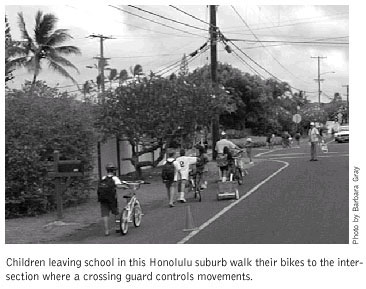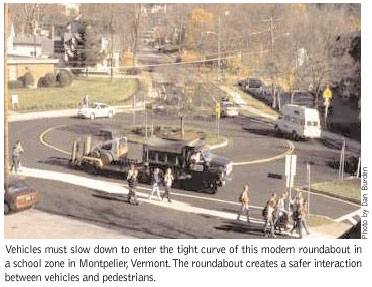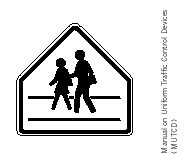51. School Zone Improvements
A variety of roadway improvements may be used to enhance the safety or mobility of children in school zones. The use of well-trained adult crossing guards has been found to be one of the most effective measures for assisting children to cross streets safely. Sidewalks or separated walkways and paths are essential for a safe trip from home to school on foot or by bike. Adult crossing guards require training and monitoring and should be equipped with a bright orange safety vest and a STOP paddle. Police enforcement in school zones may be needed in situations where drivers are speeding or not yielding to children in crosswalks.
Other helpful measures include parking prohibitions near intersections and crosswalks near schools, increased child supervision, and the use of signs and markings, such as the school advance warning sign (S1-1) and SPEED LIMIT 25 MPH WHEN FLASHING. Schools should develop "safe route to school" plans and work with local agencies to identify and correct problem areas. Marked crosswalks can help guide children to the best route to school. School administrators and parent-teacher organizations need to educate students and parents about school safety and access to and from the school. Education, enforcement and well designed roads must all be in place to encourage motorists to drive appropriately.
One of the biggest safety hazards around schools is parents or caretakers dropping off and picking up their children. There are two immediate solutions:
1) there needs to be a clearly marked area where parents are permitted to drop off and pick up their children; and
2) drop off/pick up regulations must be provided to parents on the first day of school. Drop off areas must be located away from where children on foot cross streets or access the school. If parents or caretakers can be trained to do it right at the start of the school year, they are likely to continue good behavior throughout the year.
For a longer-term solution, it is preferable to create an environment where children can walk or bicycle safely to school, provided they live within a suitable distance. One concept that has been successful in some communities is the concept of a "walking bus," where an adult accompanies children to school, starting at one location and picking children up along the way. Soon a fairly sizeable group of children is walking in a regular formation, two by two, under the supervision of a responsible adult, who is mindful of street crossings. The presence of such groups affects drivers' behavior, who tend to be more watchful of children walking. Parents take turns accompanying the "walking school bus" in ways that fit their schedules.



Purpose:
- Provide enhanced safety around schools.